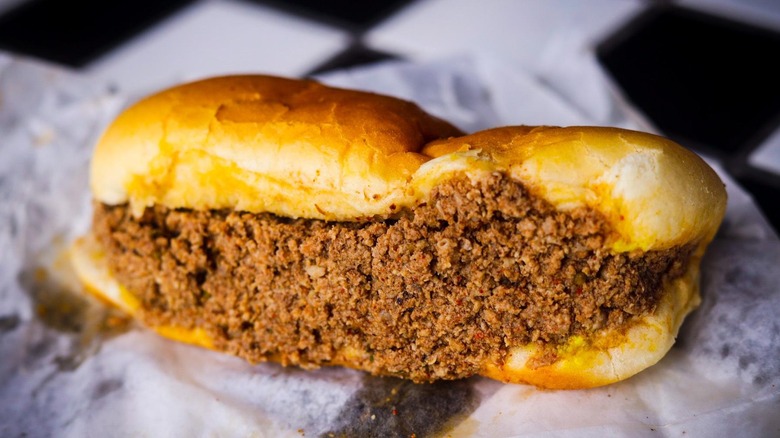The Origin Of Greek Hot Dog Sauce Isn't What You Think
Hot dogs are one of the quintessential American foods. But it isn't the actual "dog" that makes them special — it's the toppings. From ketchup and mustard to sauerkraut and Cincinnati chili, hot dog toppings range from simple to complex. Greek hot dogs certainly aren't simple: A warm bun loaded with onions and mustard, slathered with a greasy, spice-filled Greek hot dog sauce on top. Where did this delicious, albeit unique dog come from?
Like the name implies, Greek hot dog sauce comes from Greek immigrants. Following an economic crisis in the 1890s, many Greeks migrated to the United States in search of economic opportunities. Most of these immigrants settled on the east coast and began working manual labor jobs. It was up north, near Pennsylvania and New York, where Greek immigrants worked their way into owning and operating diners and hot dog stands.
Greek sauce for hot dogs was born in these early days, and was likely a twist on Greek pasta sauce. The actual origins of the dog are contested; New York Lunch East Avenue in Erie, PA, which opened in 1927, touts itself as the first to serve a Greek hot dog. But other dogs with a similar sauce were being served earlier: Coney dogs, also created by Greek immigrants, were offered back in the early 1900s, and although this sauce has noticeably different ingredients (specifically ketchup and Worcestershire sauce) and is considered more of a chili, it could be an early iteration.
The debate over Greek sauce continues
The biggest debate over this sauce is the inclusion of tomato sauce. As one of the first to make the sauce, New York Lunch's recipe doesn't use tomato sauce, leading many to believe it shouldn't be included. Online there are many recipes withouta tomato base, while others swear by the inclusion of tomato sauce. Either way, the cooking method remains relatively similar, featuring a long, slow and low simmer.
The spices in the sauce, which give it its classic Mediterranean flavor, are also difficult to pinpoint. It doesn't seem that New York Lunch will be releasing its classic spice blend, and recipes vary widely. Almost every recipe includes salt, pepper, cumin, oregano, and some sort of heat-inducing spice, such as red pepper flakes, chili powder, or cayenne pepper. After this, it's quite recipe dependent, with some including basil and garlic powder, while others opt instead for cloves and paprika; it seems there is no consensus and it's up to preference.
One thing is unanimously agreed upon — they're not authentic if they're not greasy. Though most recipes online won't specify to use a fattier ground beef, one of the standout features of the dog is the greasy, beefy sauce and the more-likely-than-not grease-soaked bun. If you want to go a bit healthier when making this sauce you can use lean beef, but consider adding just a bit of vegetable oil (no more than two tablespoons) to keep the classic greasy flavor.

